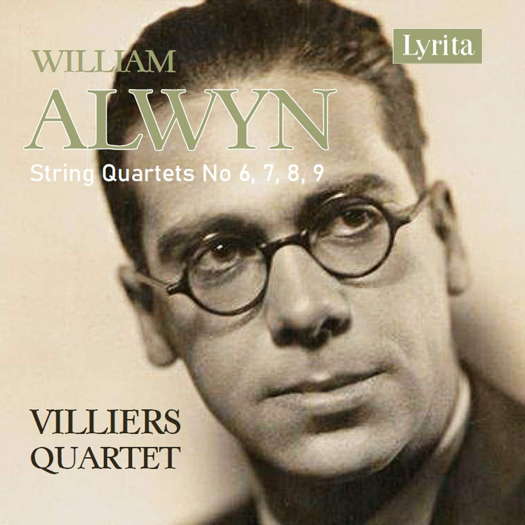 FEEDBACK: She said WHAT? Read what people think about our Classical Music Daily features, and have your say!
FEEDBACK: She said WHAT? Read what people think about our Classical Music Daily features, and have your say!

Youthful Influences
Early string quartets by William Alwyn,
heard by PATRICK MAXWELL
'... carried off with impressive dexterity by the players ...'
William Alwyn is a composer of contrasts. On the one hand he can be seen as a powerful exemplar of English twentieth-century pastoralism, following in the well-trodden line of Vaughan Williams and later Lennox Berkeley. On the other he is a progressive composer that wrote with both an inherent love of dissonance and the possibilities of the twelve-tone serialist method in mind, and developed a style that had more in common with the music of Vienna that the first half of the century produced.
Well, in a way it is easier to see that he was an eccentric mix of both. Alwyn managed to engender a feeling of delicate intimacy that weaved between the bucolic images of England whilst also displaying the technical ingenuity that threw in a whole host of brilliant musical variety.
And so he was perhaps simply a blend, but Alwyn was a composer that cannot be easily defined. He was a highly individual composer who, away from the effeteness of Britten and the vulgarity of Vaughan Williams, was able to carve a unique place in the musical scene. It is a small travesty that his work has been so unjustly neglected by the wider public.
This new recording by the Villiers Quartet showcases some of Alwyn's earliest String Quartets, which blend a youthful experimentalism with the almost plaintive melody and expressive tonality that make up all his works. All the pieces included were written between 1923-31, during part of his long connection with the Royal Academy in London, having started as a student there at fifteen, later becoming a Professor of Composition just six years later. There is some wonderful music on this disc, but it does not display the assuredness that would combine with the technical mastery of some other Alwyn works. These pieces are exuberant, as if acting as an exegesis of all Alwyn's youthful influences, of continental and jazz-like harmonies, blended with a uniquely English sense of melody.
The first work included is the Quartet in A from 1929. The first movement opens with a tune in the viola that is shared around all the instruments in different forms, creating a vivid sense of flow throughout.
Listen — William Alwyn: Allegro (String Quartet No 7 in A)
(track 1, 0:03-0:42) © 2020 Lyrita Recorded Edition :
The second movement, Passacaglia, opens with a new, less assured tune that is again used by all instruments before a tempestuous polyphony is introduced again. Alwyn is a master of contrasting the sharp sections of hectic brilliance with those of serene lyricism, a juxtaposition which is central to his musical impression and vividness. The next, Rondo, begins in much the same style, with a more modernistic, jazz-like harmonic pattern and lively musical conversation. The fourth movement, Adagio e tranquillo, is reflective, brooding and almost solemn, yet still based around the same ideas of melody and momentum, despite the almost constant pianissimo volume that makes Alwyn's intimate writing the more striking. The first movement is carried off with impressive dexterity by the players, despite some haphazard cello playing on the more boisterous sections at the beginning.
The Quartet in E minor from 1927 starts off with the same boisterousness, and features some excellent string playing from all players. This is followed by a short interlude and the jaunty Scherzo which showcases Alwyn at his tuneful, pastoral best. The final movement displays Alwyn's skill for both melody and variation, incorporating an always-changing theme and harmonisation that drives the music forwards, and the brillante flourishes that are carried off with aplomb by the ensemble.
The next Quartet in D minor from 1931 opens in a trenchant dissonance that creates the more morose, longing feel of this music.
Listen — William Alwyn: Adagio molto e tranquillo (String Quartet No 8 in D minor)
(track 9, 0:04-1:02) © 2020 Lyrita Recorded Edition :
At this point the music seems unsatisfied, impulsive, striving forwards in a disjointed series of motifs that eventually come together in the most distinct harmonies yet heard. This musical tonality, which can sometimes feel impenetrable to the listener, is displayed with an impressive mix of lively virtuosity and tenderness that helps to show the inner emotion and tension. Some of Alwyn's best music is evident here; the enchanting mix of pastoral and experimental, and the constant presence of new harmonies that help to drive any potential cadence forward. The final Allegro is another evocation of this style, building an inner momentum throughout that seems to be never resolved, and only fulfilled by the eventual culmination.
Listen — William Alwyn: Allegro (String Quartet No 8 in D minor)
(track 11, 0:01-0:55) © 2020 Lyrita Recorded Edition :
The Seven Irish Tunes that follow were written between September and December 1923 when the composer was only eighteen, and are taken from the Petrie Collection of Irish Music. They are short, simple compositions, likely a collection of experiments that developed Alwyn's love for the form of theme and variation. They are all given a suitably lively rendition by the Quartet, who well exploit their ostensibly simple potential.
The last piece included is a Quartet in One Movement from 1931, which return to much the same form as the Eighth. The inspiration for this was taken from some lines of Shakespeare, where Romeo, in his Death Scene, speaks of his 'everlasting rest' and the shaking off of 'inauspicious stars / from this world-wearied flesh'. The tentative, anguished music echoes this sentiment, providing a melancholic sense of ending that finishes the disc.
Listen — William Alwyn: String Quartet No 9 in One Movement
(track 15, 12:05-12:59) © 2020 Lyrita Recorded Edition :
Some of the pieces on display share the quality of other Alwyn; they take multiple listenings to be fully appreciated, a characteristic less common among his contemporaries. Take for example his Sonata Impromptu for violin and viola of 1939, one of the finest pieces of English early twentieth-century music, and yet sparsely recognised. Alwyn (and his second wife Doreen Carwithen) deserve their music to be much more appreciated for its blend of impressive qualities, and his ever-present grasp of technical potential and emotive effect.
Copyright © 19 May 2020
Patrick Maxwell,
Buckinghamshire, UK

CD INFORMATION - ALWYN STRING QUARTETS 6, 7, 8, 9 - VILLIERS QUARTET
FURTHER INFORMATION: WILLIAM ALWYN



